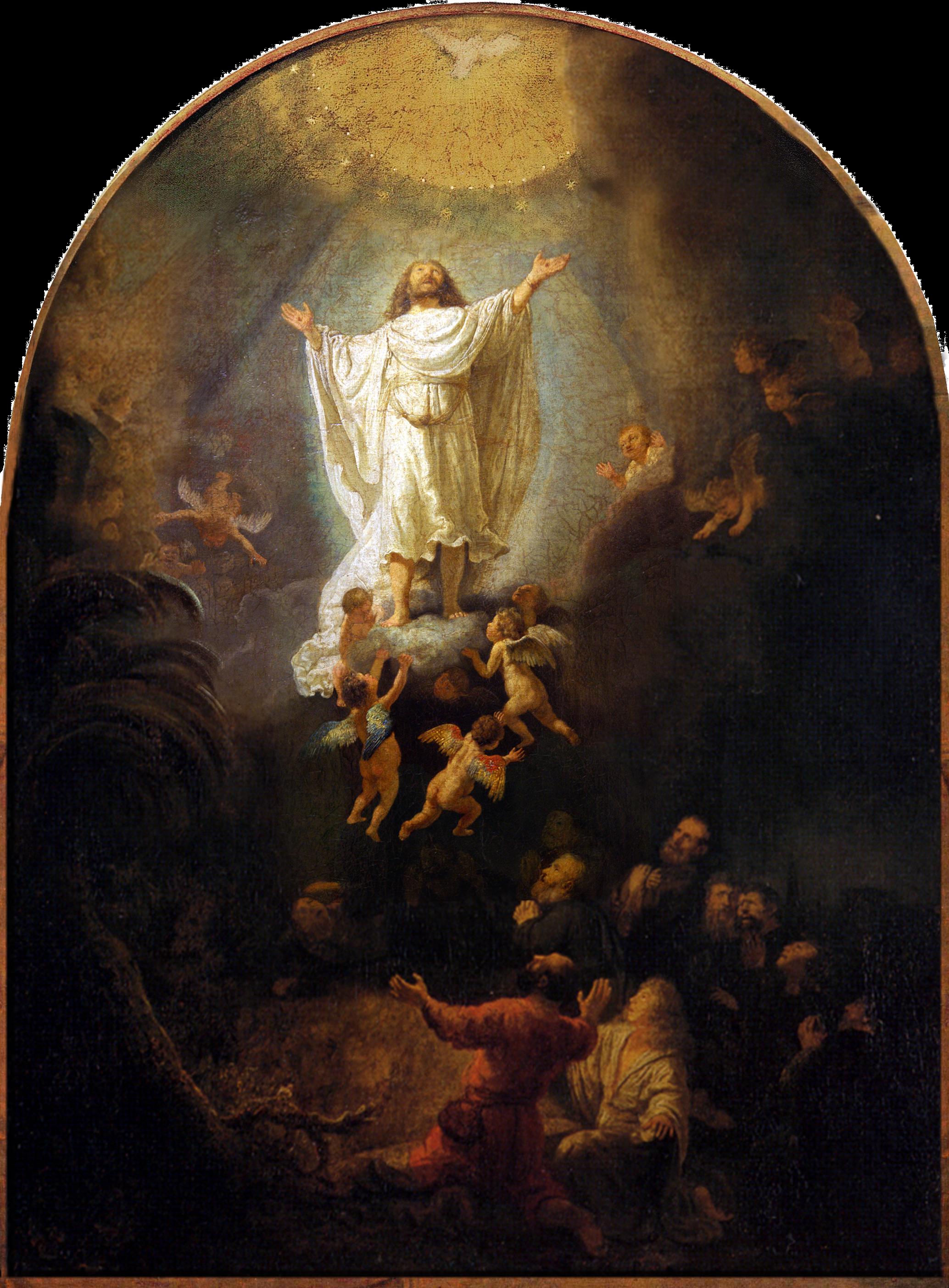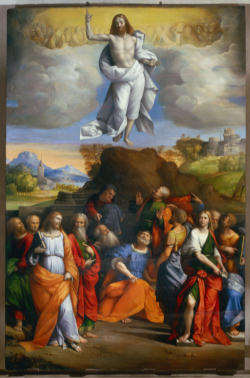Feast of the Ascension
Ascension ( ancient Greek ἡ Ἀνάληψις τοῦ Κυρίου, the reception of the Lord ', latin Ascensio Domini, ascension of the Lord ', in Switzerland and Liechtenstein: Driveway, Alemannic: Uffert ) referred to in the Christian faith, the return of Jesus Christ as the Son of God to his father in the sky. Ascension of Christ, which is 39 days after Easter Sunday, celebrated on the 40th day of the Easter festival circuit. Therefore, the festival always falls on a Thursday. The earliest possible date is April 30; the latest possible June 3.
Origin and Meaning
New Testament and early Christian theology
In the writings of the New Testament is presented in Luke 24.50-53 and EU Acts 1.1 to 11 EU, that the risen Christ during forty days after his resurrection showed to his disciples and then to the sky onto the square to the right was raised of God (the place right by the owner deserved since ancient times to the throne or the guest of honor ). The Ascension also finds mention in Mk 16,19 EU, EU 1 Pet 3:22, Heb 4,14 and 9,24 EU and EU - from a Christian perspective - Ps 68.19 EU.
The Ascension of Christ has great significance for the Christian eschatology.
" Him who humbles himself and became obedient unto death on the cross, God has exalted above every other, and given him a name which is above every name (Phil. 2:8-9 EU). "
The belief in the Assumption is attested in early Christian texts and beliefs, eg in Polycarp of Smyrna, Justin and Irenaeus of Lyons. The belief in the Assumption is also expressed in the old Roman Creed of the third century, the forerunner of the Apostles' Creed Nicene Creed of 325 and 381:
"He's on the third day he rose again and ascended into heaven. He sits at the right hand of the Father and will come again in glory to judge the living and the dead; his kingdom will have no end. "
Liturgy and Tradition
The Solemnity of the Ascension of Christ is attested in the liturgy of Jerusalem since 383/384 through the itinerary of pilgrim Egeria. According to the Lukan texts of the appointment is forty days after Easter and ten days before Pentecost.
The three days before Ascension Day are celebrated as the Rogation Days (Latin Rogationes or Litaniae minores " small litanies " ) with the so-called processions, Feldumgängen as intercession for a good harvest. The Rogation Days are in a certain tension to the joyful nature of the Easter season, which ends only with the liturgical feast of Pentecost. In Swabia are solemn processions on Ascension called " Oesch procession " (from Old German esch " cereal part of the district "). In Erftstadt- Gymnich place on Ascension Day the Gymnicher ride instead, hall procession attended by riders and Fußpilger. Also on Friday after Ascension Day, the "Hail Friday" or " showers Friday," or the following Sunday processions were common in some places. The Ascension week was therefore also called transitional week, Betwoche, Bittwoche or cross week because the processions the cross was carried in front. In addition to " integrity of creation " in continuation of the original agrarian orientation today may be motives of processions for human life and work for all, Peace, Bread for the World and awe.
In the Catholic tradition of some areas (eg in Mittenwald or in Neustift Monastery in South Tyrol), the statue of the Risen Christ's ascension through the " Holy Ghost hole" is drawn to the church store.
The nine days between Ascension and Pentecost Christ the time of Pentecost Novena is prayed in particular for the gifts of the Holy Spirit.
Resurrection and Ascension
The ratio of the resurrection and ascension of Christ was and is the subject of theological debate. In traditional theology, there is a clear demarcation for Easter, to the resurrection of Jesus Christ is celebrated on the third day after his death. Jesus went after his crucifixion, first in a "deep " localized Beyond down ( " He descended into the realm of death ", see also Hell Jesus' ascension ), from which he rose again the third day to the living. Called The Ascension of Jesus against which the later following event, that Jesus came bodily into the afterlife without (again) and to die without leaving a corpse. In this ascension he went into a "in height " located beyond (see sky). By adhering to the only concrete time indication in the Bible, so went by between the resurrection and ascension into heaven 40 days (Acts 1,3.9 f EU), although Lk 24,51 EU an ascension seems to suggest on Easter day. Therefore, the Feast of the Ascension is celebrated 40 days after Easter.
Many theologians emphasize today reversed the commonality of resurrection and ascension. After Conzelmann / Lindemann is no fundamental difference between resurrection and exaltation of Jesus: " The general rule is that Jesus' resurrection has never been understood as a mere revival of his body [ ... ]; the Easter event is Jesus' establishment of a unique dignity ( cf. Rom 1:3 f LUT), so basically resurrection and exaltation at the same time. This is true even where, as in the hymn of Phil 2:6-11 LUT only on the increase, but not of the resurrection is spoken of, or conversely where an explicit increase statement is missing ( cf. 1 Cor 15,4 f LUT). Although the accent is different, each set; However, a fundamental difference exists. "
" Resurrection and exaltation (Ascension Day) Only later are aware separated from each other, without there being, however, come to a single term (after Luke 24.51 LUT was the ascension into heaven on Easter Sunday, according to Acts 1,3.9 f LUT only forty days thereafter). ( Acts 1 LUT LUT Lk 24 ) and the other appearances of Christ from heaven [ ... ] will later distinguish between the actual Easter appearances on earth. (Acts 7,55 f LUT, Acts 9,3 ff LUT) " The fundamental event is the victory. God pulls out his son and up. This is a triumph over all the powers of this world, a triumph, to which all Christians share.
Iconography
In the early Christian catacomb there is not the ascension motif. From the 4th century, it unfolds in different game modes:
- Christ falls into heaven, and is taken from the hand of God in receiving.
- From the 6th century Christ - even at Ascension representations - surrounded by a mandorla, which is usually lifted by four angels to heaven.
- By 1000, the type of disappearing Christ comes on. It is often only the legs and feet together with the footprints remain visible, from the 14th century only the footprints.
In the Catholic iconography of the Baroque period, the subject Ascension into heaven, and the glorification of other popular saint occurs in favor of the assumption of Mary something back.
Holiday
The Feast of the Ascension is celebrated in the liturgy of the Catholic Church, the Orthodox Church and the Anglican Church as a feast. The date of the Solemnity is from the date of the movable Easter dependent.
- 2011: June 02
- 2012: May 17
- 2013: May 09
- 2014: May 29
- 2015: May 14
- 2016: May 05
- 2017: May 25,
- 2018: May 10
- 2019: May 30
- 2020: May 21
Ascension is a public holiday in Germany ( since the 1930s ), Switzerland, Austria and Belgium, Denmark, Finland, France, Greenland, Haiti, Indonesia, Iceland, Colombia, Liechtenstein, Luxembourg, Madagascar, Namibia, Netherlands, Norway and Sweden. In Italy ( Ascensione ), Poland and Hungary, the festival was abolished as a public holiday and is now celebrated in church on the following Sunday. In Italy, intensive efforts, Ascension reintroduce as a legal holiday. About 12 bills this respect are the Roman Parliament in both chambers. Numerous Italian ministers and politicians are the concerns towards positive, as high-ranking church officials.
In the secular realm, the holiday developed in Germany for Father's Day, also known as Men's Day or the Lord's Day. On this day, there are customs such as the Herrenpartie ( a carriage ride or hike in nature with consumption of alcohol ) or day trips with the whole family.
In 2008, Ascension Day coincided with the holiday " Labor Day " (May 1). This situation occurs only very rarely, before most recently in 1913 and after 2008 again until 2160th










